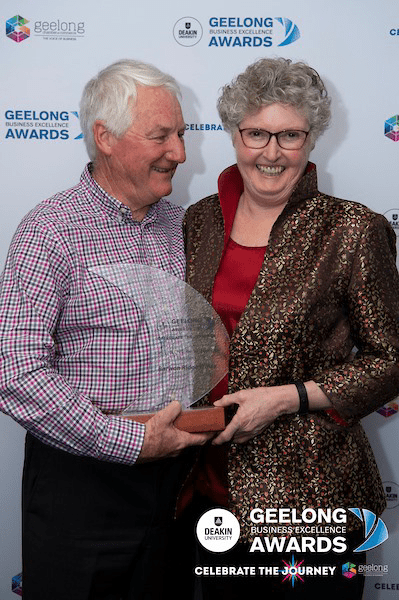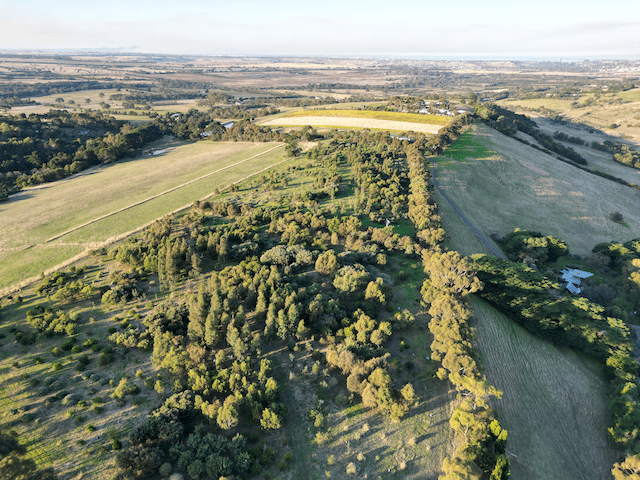About Us

Who we are
Geoff and Joan established Barwon Ridge in the Barrabool Hills in 1999. After Joan’s death in 2021 Geoff has kept their vision of a sustainable property producing fine wine going strong. Our objective has been to manage the whole property sustainably through responsible farming and land management.
There is an ongoing commitment to improving the biodiversity of the property through the revegetation of degraded areas and the protection of remnant vegetation. The approach to grape growing is to assist nature where possible and to minimise inputs.
In 2023 Barwon Ridge was the first vineyard in Geelong to achieve the internationally recognised sustainability certification from Sustainable Winegrowing Australia.




In 2022 Barwon Ridge was awarded a Best Cellar Door award by Gourmet Traveller Wine.
To visit take the Fyansford or Ceres turnoffs on the Geelong by-pass and head west for 10 minutes into the tranquil Barrabool Hills. Barwon Ridge is a great place to visit from nearby Geelong, for a day trip from Melbourne, or on the way to or from the Great Ocean Road and Bellarine Peninsula.
Revegetating Our Property

As the revegetation cover has grown on Barwon Ridge and on surrounding properties the variety and number of wildlife has increased substantially. Birds range from Wedge Tailed Eagles through to tiny honey eaters, lizards and snakes, kangaroos and wallabies all thrive in the bushland. We have also added a “Bee Hotel” that is attracting native bees and wasps.

Viticulture in the 1850’s
In the 1860’s there were many vineyards larger than the 4 hectares that Barwon Ridge is today. They included vineyards at Pollocksford (Neuchatel, Chillon and Sugarloaf Farm), Crooks Rd (Barramonga, Barwondale), Merrewarp Rd (Suisse), Ceres (Ceres, Ceres Vineyard and Orchard), Highton (Montpellier), Cochrans Rd (Victoria) and Waurne Ponds (Prince Albert).
Early vineyards were hand developed, at times without even the assistance of horses. Vineyard rows were trenched 3ft wide and 18 inches deep, manure was added to the bottom of the trench and then they were filled with soil from the next trench. ‘Hot’ manures (eg. horse, sheep, fowls) were recommended for cold (clay) soils, and fat manures (eg. cow, bullock, pigs) were recommended for warm (sandy) soils. Vine cuttings were planted directly into the prepared soil at 1m x 1 m – compared to today’s spacing of nearer 2m x 3m. Vines were trained on a single post and trellising as we see today was not used. Many parts of Europe still grow vines in this way.
Vineyards were often supplemented with orchards, particularly cherries (that were sometimes added to the wine to increase colour), and vegetable gardens. Grapes were turned into wine and spirit, or sold as fruit, often in the gold fields. Although the gold fields provided a good market for fruit and wine, it also meant that farm labour was hard to get. This led to the ongoing recruitment of many workers from Switzerland.


Join our Wine Club
Continuing the tradition
The Barrabool Hill’s first vineyard was in 1841 when Fredrick Brequet and David Pettavel planted at Pollocks Ford as it was then known. The original Swiss growers were complemented by German and even British grape growers, though the Swiss appear to have firm views about their superior skills.
“No Swiss Winegrower has yet planted a vineyard on a flat site in the Geelong District. Mr Caldwell, an English gentleman, planted a small one on a bank of the river Moorabool at Fyans Ford. The vines are healthy, grow luxuriantly, and produce abundantly, but the grapes do not acquire that perfect maturity which is necessary” John Belperraid 1859.
Wine production grew dramatically until the 1880s, when the emergence of Phylloxera lead to its decimation. It was the 1960’s before families such as the Sexton’s at Idle Vineyard started the revival of the industry.

Signs of the early days are still around. A Swiss cross can still be seen carved into a barrel log at the old Barramonga vineyard.It is still possible to see evidence of the early days of winemaking. Original cellars can be found and several sets of ruins are scattered through the hills.
The rebirth of grape growing in the Geelong region was due to the efforts of vinerons such as Daryl and Nini Sefton who established Idyll vineyard in 1966 in the nearby Moorabool Valley, and Tom Maltby and Ian Hickinbotham at Anakie.
Signs of the early days are still around. A Swiss cross can still be seen carved into a barrel log at the old Barramonga vineyard. It is still possible to see evidence of the early days of winemaking. Original cellars can be found and several sets of ruins are scattered through the hills.
Phylloxera
Phylloxera is endemic to America and so American vines have developed resistance to the insect. To overcome the mite most of Europe replanted its European varieties (Chardonnay, Pinot Noir etc) onto American rootstock. This meant the European varieties could be grown when the mite was in the soil.
In 1877 Phylloxera appeared in Geelong. A government inquiry in 1878 recommended that all vines in the Geelong area be pulled up and this was done, with the apparent exception of one Chasselas vine that is still growing today. By 1880 the industry was finished and it did not restart until the 1960s.
In 2012 Geelong was tested and declared a Phylloxera Exclusion Zone. This means that it is one of the decreasing number of wine areas in Victoria that does not have Phylloxera. Vineyards in the area are working to maintain that status and this is one of the main reasons why visitors are asked not to enter the vineyards and walk among the vines.

Return of Pinot Meunier to the Barrabool Hills.
In the 1860’s Bests from Great Western sourced Pinot Meunier cuttings from the Barrabool Hills when they established a planting at their new vineyard at Great Western in Western Victoria. Some of those original vines, are still alive today at Bests and are part of a rich heritage of rare varieties at that vineyard.
In 2017, thanks to the generosity of Bests and the drive of Jon Helmer from Geelong Cellar Door, we were privileged to be able to take cuttings from Bests so that we could reintroduce the direct descendants from these original vines back into the Barrabool Hills. Cuttings were collected in 2017 and sent away to be grafted onto phylloxera resistant rootstock in preparation for planting out.
On the first day of Spring in 2018 a band of Wine Geelong members and other enthusiastic helpers converged on our vineyard and planted out our newly named Heritage Block. The planting was efficiently finished in a couple of hours, then it was off up the road to the cellars of the original Neuchatel vineyard for a tasting of modern Neuchatel wines brought from Switzerland for the occasion.
When you drive up to the cellar door the thriving Pinot Meunier vineyard will greet you on the left hand side of the road.
Pinot Meunier is a relative of Pinot Noir and it is usually used in the production of Champaign or as Pinot Noir style still wine.Initially we are using the Pinot Meunier as a component in our sparkling wine, starting with Joan’s Sparkling Rosé. When the vines are more mature we plan to explore the production of a still wine.
Click to read more


